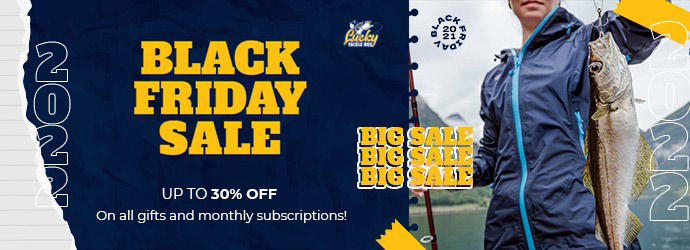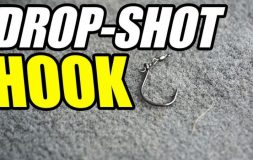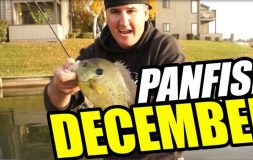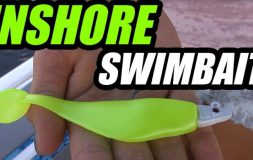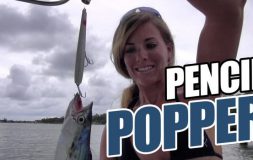Drop Shotting 101: How to catch sluggish fish with a shaking squirrel worm
During cold winter months, bass tend to be sluggish and slow-moving. Maybe it’s the frigid water temps, maybe it’s a touch of seasonal depression. Who knows?! Either way, avid anglers need to learn how to catch fish in any condition, and that requires the ability to master drop shotting and finesse fishing.
Drop shotting and finesse fishing is a delicate, subtle technique that has a very natural-looking presentation, and it provides the ability to keep a lure off the bottom of the lake with weightless, life-life action. It’s also a great method for clear water conditions, like during the winter. When properly executed, drop shotting and finesse fishing will get even the laziest, most non-aggressive bass to bite.
In Travis Moran’s most recent video, he takes us out on the water to explain the basics of drop shotting and finesse fishing including 1) rigging, 2) retrieval, and 3) location.
Let’s break ‘em down!
1) RIGGING:
When rigging a Big Bite Baits Shaking Squirrel, Travis likes to nose hook or wacky rig it.
- Nose Hook
- The nose hook rig sinks a lot faster and can be worked more efficiently over cover at the bottom of the lake.
- Wacky Rig
- The wacky rig falls slower and looks like an easy meal. It also has more attention-grabbing action on both ends.
Tag End
Travis usually starts with a 6- to 10-inch tag end. However, if you’re fishing around grass or along a muddy bottom, feel free to knot your drop shot weight a foot or two down so the worm will float above where the bass can see it.
Drop Shot Weight
The heavier the weight, the easier to control. The lighter the weight, the more it will be influenced by pressure you put on the line. Travis usually uses a 1/8- to 1/4-ounce drop shot weight depending on what he’s trying to accomplish.
Fishing Line / Rods
Finesse fishing is a slow and easy style of fishing, and it requires light line and a light, flexible rod. Travis likes to spool up with 6- to 8-pound mono or fluorocarbon. He also likes to use a finesse rod with a soft tip, so you don’t overwork the bait.
2) RETRIEVAL:
There are two great ways to retrieve a drop shot: 1) slow little lifts or 2) a smooth drag.
- Slow little lifts will lift the bait off the bottom, then let it flutter back down.
- A smooth drag will let the bait fall, move through the water, then fall again.
No matter which retrieval method you choose, you should know what your bait looks like underwater to really maximize its benefits.
Here’s a pro tip from Travis: if you find that you’re getting hit on the way down as you reel in your slack, switch to a smaller weight. A smaller weight will give your bait a longer time to fall, and it may increase the number of bites you get throughout the day.
3) LOCATION:
When you’re fishing a drop shot, make sure you’re in an area with fish nearby. This is a slow retrieve, so you want to be methodical with it!
When the bites get tough, you can usually rely on main lake points. Use a map to locate the biggest points that stick way out in the lake – places that bass like to school up in when the water temperatures drop.
If you still have no luck, move back into creek channels and island tops. Fish love to hunker down around structure when they’re not actively feeding.
If you’re fishing in clear water, fish will see your bait from a long way off. So be patient! Slowly work your bait for a couple of casts. If you still don’t get any bits, move on to the next piece of structure.
Thanks for the tips, Travis!
+++
Drop shotting and finesse fishing can be effortless when you figure it out. When it comes to becoming an all-season angler, having the right baits is half the battle. You also need to how to rig ‘em, how to retrieve ‘em, and where to throw ‘em so you can maximize your LUCK on the water!
Watch the full “Shaking Squirrel” video or read the transcription below:
+++
How To Catch More Fish With A Big Bite Baits Shaking Squirrel – Video Transcription
And there it is. We are drop shotting. This is one of the most natural presentations there is, and people really tend to complicate this technique when the reality is, with this style of fishing, less can be more. And confidence is key.
Good morning and welcome everyone. Today we’re going to be going over the general basics of drop shotting to give you the confidence and the right peace of mind knowing that you’ve rigged it up correctly, you’re getting the right action out of it, and lastly, that you are around fish.
We’re going to complete the circle of a drop shotter, so you now know how to set it up, but you have the right mind frame. And just like Harry Potter with that crazy little stick he has as a wand, the drop shot starts with the right worm. So, we’ll be using a Big Bite Baits Shaking Squirrel, which we’re gonna break down further in rigging.
- 1) RIGGING
So, first with the Shaking Squirrel, it actually is made of very soft plastic, which gives it a very natural look. Then this flat belly it has catches a lot of water and gives it additional action. Next, these baits were designed by Jeff Kriet for clear water situations. So, it comes in an assortment of great clear water colors.
Next is the set up of this bait. We start with a hook, then on the tag end of that knot, we’re gonna attach our drop shot weight. Now with the hook, I start with a size one drop shot hook with a Palomar knot. Now when I attach a worm I either nose hook it or I wacky rig it. The nose hook set up is going to sink a lot faster and it’s going to be a lot more mainlined presentation that I can work a little bit more efficiently down some cover and things like that.
Whereas the wacky rig is a slower presentation. It’s going to fall a lot slower, making it look more natural, like something dying. But then also when it’s on the bottom and I’m lifting, where I’m subtly kind of shaking it, both ends are really gonna, you know, have a lot more action than just that one tail at the end where it’s nose hooked.
Next is your tag end. This is how far you’re going to put the drop shot weight down from the hook. Now there’s different reasons for having different lengths. I usually start with about a six- to 10-inch tag end. Now if you want to go longer, there’s a couple reasons to do so. The first reason is if you’re fishing around some grass or a muddy bottom where that grass or that soot comes up a foot or two, you can actually put that drop shot weight a foot or two down so that little worm will actually sit higher up above that cloud, you know, any kind of grass or whatever, a noise down there, and the fish will be able to see it.
The second reason is that fall of the bait. If you just have a small tag end, that bait’s gonna fall down quickly. But if you have it up two feet, um, when you give it slack, that bait’s gonna slowly and naturally fall down. When you lift it back up, it’ll come back up two feet and then it’ll fall back down. So, a few different reasons that you can change that tag end as long as you know what that’s changing down underneath the water.
Now, the size of the weight is obviously gonna impact how fast the bait gets down to the bottom. I usually use anywhere from a one eighth to a one quarter ounce weight and I’ll vary depending on what I’m trying to do or what I’m trying to accomplish with that. Um, also when you’re using a heavier weight, it’s easier to keep that bait in one place. If you have a quarter ounce weight and cast it up on a little spot, you can really slowly work that bait and it’s not going to move much. But if you have a very light weight, any kind of pressure you put on the line is going to move that bait out of the strike zone.
Next, is fishing line. I spool up with six- to eight-pound mono- or fluorocarbon. Remember, this is finesse technique, so you really want that light line. Lastly is the rod. You want a nice finesse rod. I’m using the finesse stick right here. Um, the idea is you want a soft tip so you’re not overworking the bait. If you have too stiff of a rod, when you lift up and put pressure on that line, it’s actually going to be pulling that bait away from the targeted area you’re trying to fish. But if you have a nice soft tip, you’re going to be able to apply a little pressure to that bait, without having to move it too much, and you’ll be able to feel those subtle little bites.
Also, having a rod that has a lot of give to it is going to help fight these fish a lot better. These tiny little hooks, they have a high percentage hookup rate, but they only skin hook the fish. If you have a real stout rod and that fish yanks hard, a lot of time they can tear that little layer of skin and get away from you. So, the right finesse rod is very important.
- 2) RETRIEVAL
Now, no matter how you’re retrieving this back, whether you just make slow little lifts with the rod tip, or you have that rod tip down and you want to just drag it, it’s important to know what happens every time you tighten up that line.
Oh man, I’ve got a fish! Oh, I was not ready for that! Okay. So, when you tighten up that line, what you’re doing is you’re lifting that bait up off the bottom. And if you give it slack again, that bait is fluttering back down. This is something if you don’t put too much tension in your line, you can repeat this multiple times without moving that bait much at all. But if you put a little tension on that line, that bait’s gonna drag a couple feet and then you can repeat the process, you can let it fall, lift it back up a little bit, let it fall again. But as long as you know what that bait is doing down there without much effort from you, you can really maximize the benefits that this technique has.
Okay now first, when you make your cast towards your target, you want to watch that bait fall. If you find that you’re getting a hit on the way down or as you reel in that slack, you realize there’s a fish on there and that happens a couple of times, you may want to think about using a smaller weight. What this is going to do is that’s going to slow down that fall, that bait’s gonna take longer to sink because those fish seem to be feeding on it on the fall. If you give it longer to fall, that may increase more bites that you get throughout the day.
Now, switching to the opposite side of that, if you’re finding that you really have to work this bait slowly along the bottom to get any bites, you can increase the size your weight. Go up to a quarter ounce weight and you’ll keep that bait in contact with the bottom. You’ll be able to keep that bait in one spot a lot easier so you can spend more time enticing those finicky bass to actually bite.
- 3) LOCATION
Now when you’re fishing the drop shot, you want to make sure you’re in areas where there are fish nearby. This is such a slow retrieve. You really want to be methodical with it. You want to make sure you’re in an area where you could actually have some success.
Now when the bite gets tough, if you’re struggling finding any fish, you can usually rely on main lake points. If you take a look at a map and you just circle some of the biggest points that stick way out in the lake, you can pretty much bet that there’s going to be fish somewhere on that point year-round.
After I eliminate points or after I go fish those, then I’ll move back into creek channels, focusing on any kind of little secondary points that are back in those channels or you know, any kind of manmade structure like a launch ramp, some kind of road bed. You can work the side, you can work on top of it. And then of course, island tops as well. But those are all very productive areas to really be able to slow down those fish. They’ll hunker down around structure. When they aren’t feeding, fish will go just relate to that cover, hang out until they go up and feed again. But you can still catch them when they’re not actively feeding when you work this drop shot.
Now generally when I pull up to a piece of structure that I’m going to fish, let’s say it’s a point, I’m going to cast the main spot. I’m gonna cast right up on that point about five to 10 feet of water. And then I’ll move, I’ll slowly drag it or work it away from that. If I don’t get bit, I’ll make a cast of 10, 20 feet over one of the sides of the point. And usually the steeper side I like. If I don’t get anything there, I’ll make one shallow. And if I don’t get one on either of those casts, then I’ll move on to another piece of structure.
When you’re fishing clear water, fish will move a long ways away. So, if you cast up on a point, if there’s fish anywhere in that vicinity, they will see it. It’s clear water, they’ll see it drop and as you’re slowly working that bait there for a long time, that gives them time to come over, take a look at it and finally bite it. So if you make a couple of casts and don’t get bit, go to your next piece of structure and pick that apart.
Oh yeah. Oh yeah. There we go. Oh yeah, here we go. Man! This technique can be so effortless once you figure it out. Once you have the confidence in realizing that you have the right bait, like this big bites shaking squirrel, you know that that bait’s working down there. It’s looking natural! You just need to put it in front of the fish for the right amount of time and eventually good things are gonna happen.
But it’s important when you’re fishing down there to be thinking about what that bait’s doing. When you’re lifting, know that bait’s coming up. And then when you give it slack, that bait is naturally falling back down. But anyway, when you figure it out, the fishing can be outstanding with a drop shot – a technique that everyone should have in their arsenal.
You know, as we’ve talked a lot about all these reaction baits, these different techniques to locate fish and cover a lot of water. Well, when you find productive areas, you can go back in with a drop shot and you can catch those fish that didn’t want to bite, didn’t want to go for that easy meal. You know, they weren’t suckers for that drop shot, or that reaction bait, though you come back through, you can catch them with a drop shot and catch a lot more fish.
Anyway, guys, I hope you enjoyed this drop shot special. I hope this makes you a complete drop shot connoisseur. Anyway, if you liked the video, hit the thumbs up. Leave a comment below, subscribe to our YouTube channel and I’ll catch you out on the water! – Travis Moran, Chief Fishing Officer at Lucky Tackle Box
###


